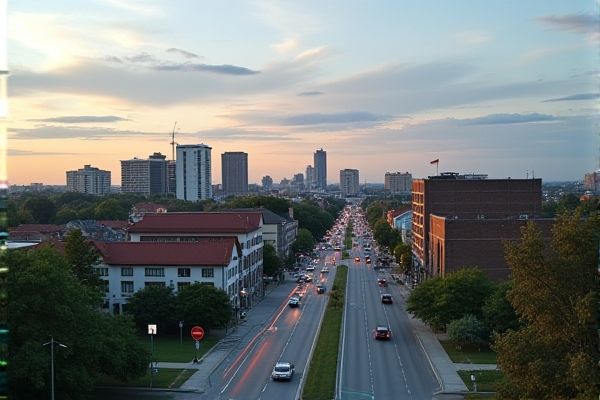
Transportation and commuting in Kentucky: Public transit systems vary by city. Louisville has TARC bus service. Lexington offers Lextran bus routes. Car ownership is common. Interstate highways: I-64, I-75, I-65. Rural areas may lack public transit. Carpooling encouraged in urban areas. Seasonal weather affects driving conditions. Airports: Louisville, Lexington, Northern Kentucky. Bicycle lanes expanding in cities.
Public transit systems vary by city.
Kentucky's public transit systems vary significantly by city, with urban areas offering fixed route services and some smaller urban systems using deviated route systems, while rural areas rely on demand-response services. Different counties have multiple transit agencies, including large urbanized systems like Lextran, TARC, and TANK, as well as various rural and community-based transit providers. For more detailed information, visit the Public Transit website.
Louisville has TARC bus service.
The Transit Authority of River City (TARC) serves as the primary public transportation provider for Louisville, Kentucky, and parts of Southern Indiana, operating over 40 bus routes. These include fixed routes and express services, with innovative initiatives such as the Dixie Rapid bus rapid transit line and the ZeroBus electric bus service. By doing so, TARC aims to enhance mobility and reduce reliance on private vehicles, significantly contributing to sustainable urban transit solutions. For more information about their services and ongoing initiatives, visit their official website.
Lexington offers Lextran bus routes.
Lextran, the public transportation system in Lexington, Kentucky, operates 25 bus routes, including Route 5 - Nicholasville Road, with services running from 5:00 AM to midnight, seven days a week. The system includes mainline routes, connecting routes, and specialized services like the UK Blue and White routes, with a mixed fleet of diesel, hybrid-electric, and electric buses.
Car ownership is common.
Car ownership is highly prevalent in Kentucky, with approximately 3,650,324 registered cars and a ratio of 1.119 vehicles per 1000 people, indicating a high level of car ownership among the population. For a comprehensive exploration of car distribution across the United States and insights into where they might end up, you can visit the Nexus Auto Transport website.
Interstate highways: I-64, I-75, I-65.
In Kentucky, Interstate 64 spans 191 miles, connecting major cities like Louisville, Frankfort, Lexington, and Ashland, with key junctions including I-65, I-71, I-264, and I-265 in Louisville and I-75 in Lexington. Interstate 75 runs 192 miles from the Tennessee border to the Ohio border, intersecting with I-64 near Lexington and I-71 at the Ohio state line, while I-65 connects Tennessee to Indiana through Louisville, intersecting with I-64 and I-71.
Rural areas may lack public transit.
Rural areas in Kentucky often rely on demand-response public transportation services, which require patrons to schedule trips in advance, as fixed-route services are less feasible due to the spread-out population and lack of density. For more information on these essential services, visit the Public Transit page. These adaptable services are vital for providing mobility and access to essential resources in less densely populated regions.
Carpooling encouraged in urban areas.
Carpooling in urban areas of Kentucky, such as Lexington, is encouraged through programs administered by Lextran in partnership with Enterprise Rideshare. These initiatives help employees organize carpools and vanpools to reduce costs and minimize environmental impact. For more information, you can explore the Ride-Sharing Program to learn about the benefits and how to participate in these carpooling solutions.
Seasonal weather affects driving conditions.
Seasonal weather in Kentucky significantly affects driving conditions, with late fall cold fronts and early winter air leading to slick roads, black ice, and reduced visibility. This necessitates cautious driving practices such as reducing speed, avoiding cruise control, and increasing stopping distances to ensure safety. For more detailed guidelines and tips on navigating these challenging conditions, visit the Rhoads & Rhoads blog dedicated to Safe Driving in Kentucky Winter.
Airports: Louisville, Lexington, Northern Kentucky.
In Kentucky, the primary commercial airports include Louisville Muhammad Ali International Airport (SDF) in Louisville, Blue Grass Airport (LEX) in Lexington, and Cincinnati/Northern Kentucky International Airport (CVG) in Northern Kentucky. These airports serve as major hubs for passenger and cargo traffic, with CVG being a significant cargo global hub and LEX and SDF providing regional and national flight services. For more detailed information on these airports and their flight services, you can visit the Airport Guide.
Bicycle lanes expanding in cities.
Cities in Northern Kentucky, such as Covington and Newport, have approved a plan to expand and connect biking infrastructure. This comprehensive initiative includes the development of dedicated bike lanes, shared-use paths, and strategic policy changes aimed at enhancing cyclist safety. The impetus for these improvements, in part, stems from the [tragic death](https://www.wcpo.com/news/local-news/finding-solutions/infrastructure-plan-being-finalized-in-northern-kentucky-to-bolster-bicyclist-safety) of a cyclist in 2022, highlighting the critical need for safer biking conditions across the region.
